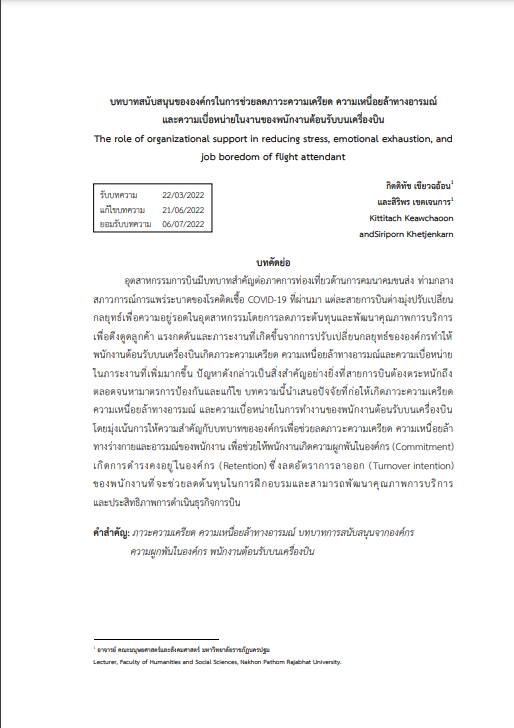The Supporting Role of The Organization in Reducing Stress Emotional Exhaustion and Boredom in The Job of A Flight Attendant
Keywords:
Stress, Emotional Exhaustion, Organizational Support Roles, Organizational Commitment, Flight AttendantsAbstract
The aviation industry plays an important role in the tourism sector by providing transportation. When the aviation industry began to expand more in every moment, it created intense competition. Each airline is aiming to adjust its strategy to survive in the industry by reducing the capital and improving service quality in order to attract customers. The pressure and workload of changing corporate strategy puts flight attendants on stressful status, emotional exhaustion and boredom in the rising workloads. Such problems are extremely important for the airline organization to be aware of and find corrective measures. The purpose of this article is to share the reasons for each specific task, personal characteristics and pressure from society and organizations, which are factors that cause stress, emotional exhaustion and the boredom of working for a flight attendant and focus on the role of the organization to help reduce stress, physical and emotional exhaustion of employees, to help employees to engage in the organization (Commitment) ,to remain in the organization (Retention) which reduces the turnover rate (Turnover intention) of employees to reduce training costs and can improve service quality and overall business performance of the organization.
References
กิตติทัช เขียวฉอ้อน. (2564). แนวทางการสร้างความประทับใจแก่ลูกค้าของธุรกิจในอุตสาหกรรมบริการท่ามกลางสภาวะความปกติใหม่ (New Normal). วารสารการบริหารการปกครองและนวัตกรรมท้องถิ่น, 5 (1), 201-212.
จิระพร อุดมกิจ. (2539). ปัจจัยที่มีผลต่อความเครียดในการทํางานของบุคลากรคอมพิวเตอร์ในเขตกรุงเทพมหานคร. วิทยานิพนธ์ศิลปศาสตรมหาบัณฑิต สาขาวิชาจิตวิทยาอุตสาหกรรม บัณฑิตวิทยาลัย มหาวิทยาลัยธรรมศาสตร์.
ธันยพร วาศประเสริฐ. (2550) ความสัมพันธ์ระหว่างปัจจัยในการทำงาน ความสามารถในการเผชิญและฟันฝ่าอุปสรรคและความเครียดของพนักงานฝ่ายลูกค้าสัมพันธ์: กรณีศึกษา บริษัททรูมูฟ จำกัด มหาวิทยาลัยธรรมศาสตร์. กรุงเทพฯ. มหาวิทยาลัยธรรมศาสตร์
สงวน ลือเกียรติบัณฑิต. (2542). อาการเหนื่อยหน่ายในการทำงาน: ประวัติการพัฒนามโนทัศน์ความหมาย และการวัด. วารสารมหาวิทยาลัยสงขลานครินทร์, 5 (2), 168-178.
โสภณ ตระการวิจิตร. (2559). บทบาทสนับสนุนขององค์กรในการช่วยลดภาวะความเครียด ความเหนื่อยล้าทางอารมณ์ และความเบื่อหน่ายในงานของพนักงานต้อนรับบนเครื่องบิน. กรุงเทพฯ: สถาบันบัณฑิตพัฒนบริหารศาสตร์
Chang, C.-P. & Chiu, J.-M. (2009). Flight attendants’ emotional labor and exhaustion in the Taiwanese airline industry. Journal of Service Science and Management, 2 (04), 305.
Chen, C.-F. & Chen, S.-C. (2012). Burnout and work engagement among cabin crew: Antecedents and consequences. The International Journal of Aviation Psychology, 22 (1), 41-58.
Cho, J.-E., Choi, H. C. & Lee, W. J. (2014). An empirical investigation of the relationship between role stressors, emotional exhaustion and turnover intention in the airline industry. Asia Pacific Journal of Tourism Research, 19 (9), 1023-1043.
Cooper, C. L. & Cartwright, S. (1997). An intervention strategy for workplace stress. Journal of psychosomatic research, 43 (1), 7-16.
Dallimore, K. S., Sparks, B. A. & Butcher, K. (2007). The influence of angry customer outbursts on service providers' facial displays and affective states. Journal of Service Research, 10 (1), 78-92.
Eisenberger, R., Fasolo, P. & Davis-LaMastro, V. (1990). Perceived organizational support and employee diligence, commitment, and innovation. Journal of Applied Psychology, 75 (1), 51.
Eisenberger, R. & Stinglhamber, F. (2011). Perceived organizational support: Fostering enthusiastic and productive employees. Washington, D.C.: American Psychological Association.
Eisenberger, R. et al. (2002). Perceived supervisor support: contributions to perceived organizational support and employee retention. Journal of Applied Psychology, 87 (3), 565.
Ekman, P. (1973). Cross-cultural studies of facial expression. In P. Ekman (Ed.), Darwin and facial expression: A century of research in review (pp.169 - 222). New York: Academie Press
Eurostat. (2005). Europe in figures: Eurostat yearbook 2005 (Vol. 1): Bastern Africa: Flagship Publications.
Freudenberg, H. J. (1974). Staff burnout. Journal of social issues, (1), 159-164.
Gilbert, D. & Wong, R. K. (2003). Passenger expectations and airline services: a Hong Kong based study. Tourism Management, 24 (5), 519-532.
Grandey, A. A. (2000). Emotional regulation in the workplace: A new way to conceptualize emotional labor. Journal of occupational health psychology, 5 (1), 95.
Hochschild, A. R. (2012). The managed heart. Berkley, CA: University of California press.
Hur, W. M., Moon, T. W. & Jun, J. K. (2013). The role of perceived organizational support on emotional labor in the airline industry. International Journal of Contemporary Hospitality Management. 25 (1), 105-123.
Judge, T. A., Scott, B. A. & Ilies, R. (2006). Hostility, job attitudes, and workplace deviance: test of a multilevel model. Journal of Applied Psychology, 91 (1), 126–138.
Khetjenkarn, S. & Agmapisarn, C. (2020 a). The effects of emotional labour on the outcomes of the job and the organization: Do the differences in age and the manager’s emotional intelligence have any impact in the hotel business? European Journal of Tourism Research, 25, 2504.
_______. (2020 b). Individual employee factors affecting emotional labor and job outcomes: a case study of hotel frontline employees in Phuket. ABAC journal, 40 (1), 58-84.
Lee, R. T. & Ashforth, B. E. (1996). A meta-analytic examination of the correlates of the three dimensions of job burnout. Journal of Applied Psychology, 81 (2), 123-133.
Leiper, N. (1979). The framework of tourism: Towards a definition of tourism, tourist, and the tourist industry. Annals of Tourism Research, 6 (4), 390-407.
Luckmann, J. & Sorensen, K. C. (1975). What patients' actions tell you about thier feelings, fears & needs. Nursing2021, 5 (2), 54-61.
Lumsdon, L. & Page, S. (2004). Tourism and transport-Issues for the new millennium. Oxford: Elsevier.
Morash, E. A., & Ozment, J. (1994). Toward management of transportation service quality. Logistics and Transportation Review, 30 (2), 115.
Robbins, S. P. (2001). Organisational behaviour: global and Southern African perspectives: London: Pearson
Sinanuwong, P., Agmapisarn, C. & Khetjenkarn, S. (2021). Linking Cabin Crew’s Motivation to Service Performance: The Mediating Role of Ambidextrous Behavior. ABAC journal, 41 (3), 155-173.
Skinner, B. F. (2014). Contingencies of reinforcement: A theoretical analysis (Vol. 3). Cambridge, MA: B.F. Skinner Foundation.
Xuan, X. et al. (2021). Will COVID-19 threaten the survival of the airline industry? Sustainability, 13 (21), 11666.
Yoon, J. & Lim, J.-C. (1999). Organizational support in the workplace: The case of Korean hospital employees. Human Relations, 52 (7), 923-945.

Downloads
Published
How to Cite
Issue
Section
License
Copyright (c) 2022 Journal of Humanities and Social Sciences Nakhon Pathom Rajabhat University

This work is licensed under a Creative Commons Attribution-NonCommercial-NoDerivatives 4.0 International License.
Journal of Humanities and Social Sciences Nakhon Pathom Rajabhat University





